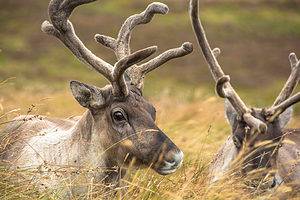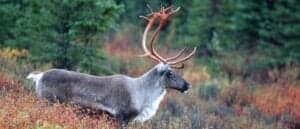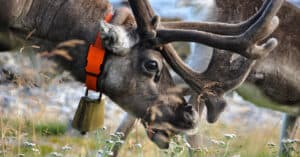Native to the Arctic region, reindeer symbolize resourcefulness and knowledge, making them the most emblematic animal of Christmas. The reindeer are also one of the staples for the survival of arctic people, as they would use the animals for transportation, food, and clothing.
There are around 7 million reindeer spread across the Americas, Eurasia, and Europe, but the population has been declining for the past few years. Let’s discover more about this species!
Where Can You Find Reindeer in the Americas?
North America is home to almost half the entire population of reindeer in the world, and you can find them in the tundras and forests of Canada and Alaska.
Today, there are no wild reindeer in the U.S., but northernmost states such as Idaho and Washington occasionally see a small herd of fewer than 100 animals. Domesticated caribou are much more common, and there are plenty of ranches and farms strewn across the country where you may see these animals.
Largest Reindeer Herd in the Americas
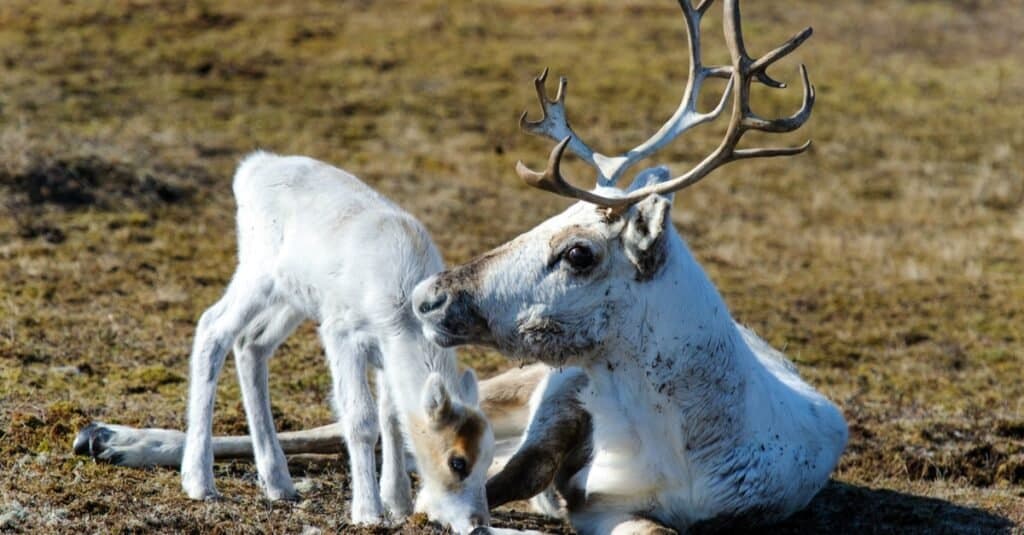
Female reindeer have antlers to protect themselves and their calves in an all-female herd.
©V. Belov/Shutterstock.com
Reindeer are group animals who usually stay close to their family during winter. When it is time to migrate, these groups come together to travel, forming herds of thousands as they search for food and a better climate. We name these herds according to the areas where the most calves are born, and studying these large groups can provide scientists with insight into climate and the local ecosystem. Reindeer are also incredibly significant for the cultural and economic aspects of native arctic people.
The largest herd in North America is known as the Porcupine Caribou herd, with a population of over 200,000 reindeer recorded since 2017. Although other herds have seen a decline in their numbers, the Porcupine herd has remained stable with high numbers. This herd receives its name for the Porcupine River, which extends over 500 miles from Canada to Alaska, and they have the longest land migration route out of all land mammals. Over the winter, the Porcupine herd travels over 1,500 miles from the boreal forests in Yukon to the coastal plains of Beaufort Sea.
Migration commences in the spring while the female reindeer are still pregnant. The calves are then born alongside the river during the first few weeks of June. During this period, the herd is at its most vulnerable, as the calves depend on their mothers for milk.
What Is the Porcupine Caribou Management Board?
The Porcupine Caribou Management Agreement was established in 1985 between the Government of Canada, Yukon, Northwest Territories, and councils of native tribes. This agreement seeks to protect and conserve the habitat and population of the Porcupine herd.
This agreement established the Porcupine Caribou Management Board (PCMB) to facilitate the exchange of information amongst the public, researchers, and other management agencies. The board is in charge of the annual reports regarding the herd, and they also conduct a yearly assessment for the harvesting of the reindeer.
Joe Tetlichi is the current chair of the PCMB. The other eight appointed members are mainly composed of representatives from the indigenous populations and members of each government.
What Is the Difference Between a Reindeer and a Caribou?
Reindeer and caribou belong to the same species — Rangifer tarandus — but these closely related cousins have a few key differences.
Caribou usually refers to the wild, large animals native to North America. They were never domesticated, and there are three sub-species: woodland caribou, peary caribou, and barren-ground caribou. These animals are usually more migratory.
Reindeers, on the other hand, originated in the northern countries of Eurasia. These animals are slightly smaller and were domesticated in the 11th century for their meat and pelt.
Other North American Reindeer Herds
North America has a wide variety of biomes and diverse ecosystems that allow many subspecies of reindeer to thrive. The largest herds are in Alaska and Canada, spreading across several territories.
Western Arctic Caribou Herd
Also known as WACH, this herd is one of the largest in Alaska, extending from Wainwright to Kotlik, and they migrate yearly along the Arctic Ocean to their calving grounds. The population of this herd is around 160,000 animals, but this number has been known to change drastically through the years. At its peak, the WACH had over 500,000 reindeer, but during the ’70s, the herd barely reached 70,000 animals.
Central Arctic Caribou Herd
This herd gathers near Teshekpuk Lake for the calving season, which is part of the National Petroleum Reserve. In 2010, the Central Arctic herd peaked with a population of almost 70,000 reindeer. However, this number decreased by more than half in the following years. Currently, there are around 30,000 animals in this herd.
Ahiak/Beverly Herd
Although they are different herds, the Ahiak, Beverly, and Qamanirjuaq herds are often referred to as a whole because they constantly overlap during migration. They are located in Saskatchewan, Nunavut, and Manitoba. The Ahiak herd is the smallest of the three, with around 70,000 animals. The Beverly herd, on the other hand, has over 100,000 reindeer. However, the Qamanirjuaq is the largest, with a population of almost 350,000 in 2008. This number has unfortunately decreased at an alarming rate every few years, and they have already lost over half that population.
George River Herd
This herd, also known as the GRCH, is located in Quebec and Labrador. The GRCH used to be the world’s largest herd, with almost a million reindeer. Today, however, they are one of the smallest groups in North America, with barely 7,000 animals.
Leaf River Herd
Native to northern Quebec, the LRCH group of woodland caribou moves across the southwest regions of Nunavik. This herd used to have a population of over 600,000 animals, but it is currently down to 190,000 reindeer. Researchers believe the LRCH could face extinction by 2080.
Why Are Reindeer Populations Decreasing?
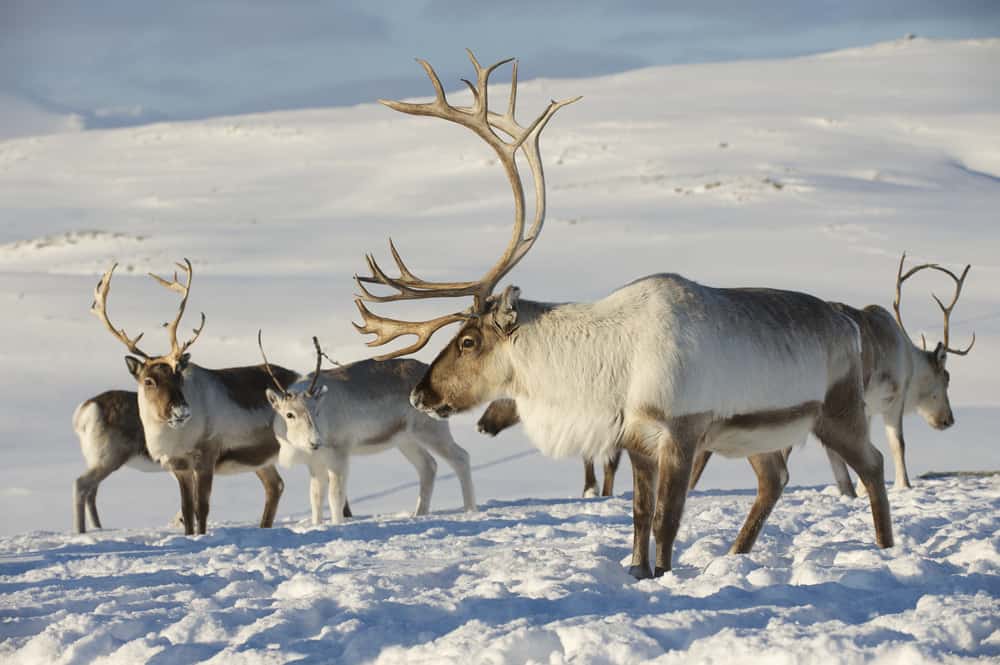
Overhunting causes the reindeer population to reduce.
©Dmitry Chulov/Shutterstock.com
In most herds, the reindeer population has dramatically decreased, with several groups losing over half their animals. Several groups are dedicated to protecting these animals by controlling hunters and conserving their habitats. But why is this extreme decline still happening?
Some researchers believe it is due to the lack of genetic variation among subspecies. Since reindeer are split into several groups, they do not usually breed with other herds, which also causes diseases. Climate change also has a significant impact. The increasing temperatures in the Arctic regions cause changes in the vegetation, meaning there is less food available for adults and calves alike. Additionally, this alters their migration routes to places that governments might not take into account when land planning.
Lastly, overhunting is a prevalent issue. While indigenous people use every part of the animal for food and clothing, poachers usually only harvest the antlers from several reindeer at once.
Up Next:
- What Do Reindeer Eat? 7 Important Foods for Their Diet
- Reindeer in the Arctic: How Do They Survive?
- Reindeer Antlers: Everything You Wanted to Know
The photo featured at the top of this post is © Dmitry Chulov/Shutterstock.com
Sources
- Alaska Department ofFish and Game, Available here: http://www.adfg.alaska.gov/index.cfm?adfg=pressreleases.pr03022011
Thank you for reading! Have some feedback for us? Contact the AZ Animals editorial team.




